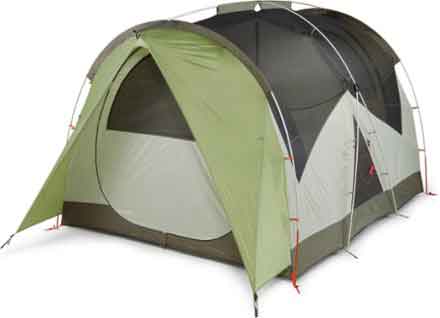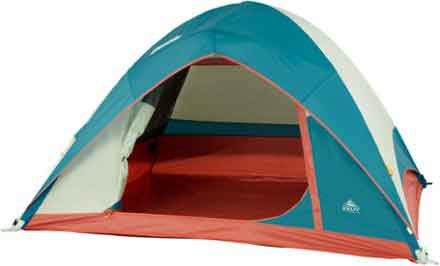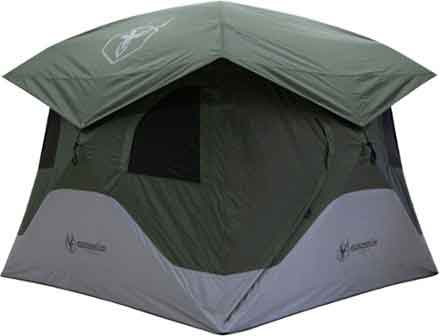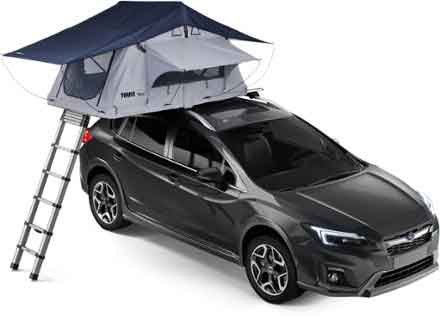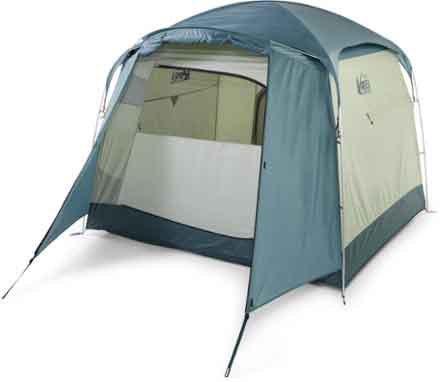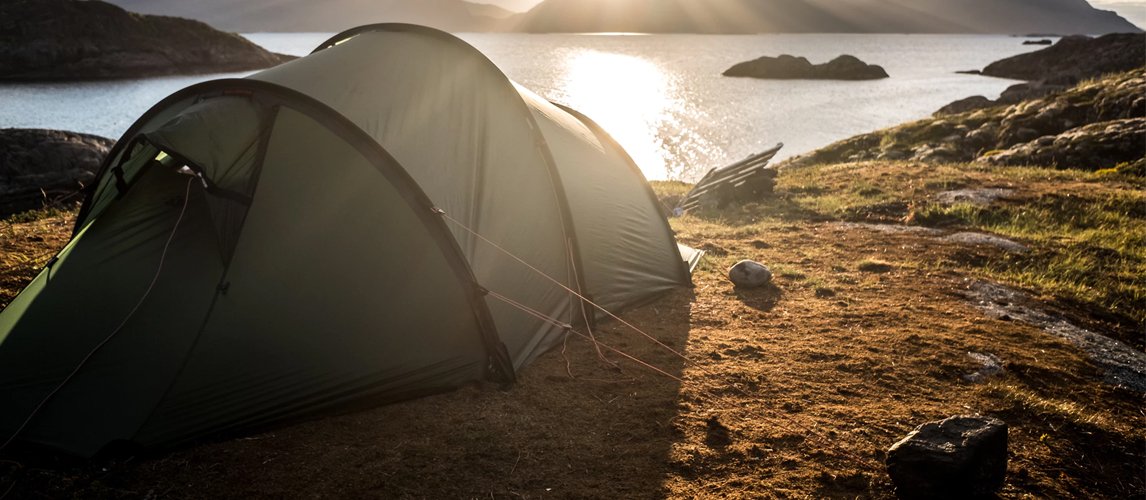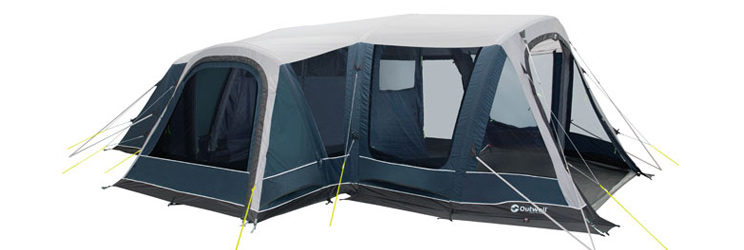REI Co-op Wonderland 6 Tent
- Floor area: 83.3 sq. ft.
- Vestibule area: None
- Peak height: 75 in.
- Number of doors: 2
- Packaged weight: 22 lbs. 15 oz.
Test Results: One tester dubbed this palatBuy hereial tent his “party house,” and we couldn’t agree more. Not only is the 75-inch peak one of the highest in our test, but this behemoth serves up 75 square feet of space—bigger than some brick-and-mortar bedrooms. To that end, the REI Co-op Wonderland 6 comes with a divider, so campers can create two rooms in the rectangular floor plan, each with its own entrance. Testers had no problem fitting three sleepers on each side, but we highly recommend turning the front room into a lounge with chairs and a card table if you’re not maxing out the capacity.
The tent doesn’t feature any true vestibules, but awnings on each side provide plenty of room for staying out of the rain while you take your boots off. On clear days, you can roll back the awnings to soak up some sun. And unless you’re filling it to capacity (which was rare for our testers), you’ll have plenty of room inside the main area for storage. If you really want a spacious vestibule, go all out: Connect the Wonderland Mud Room ($125, sold separately) to give yourself a 56-square-foot foyer. “It’s like our gear garage,” says one tester. “At night, we move our chairs, side table, firewood and the kids’ bikes inside. If it’s raining, we’ll even eat in there.” The Wonderland 6 performed well in extended precipitation and wind when properly guyed out, and testers reported no leaking, even when it was pitched on the lawn when the sprinklers went off (all in the name of good testing). But note that a shelter this tall with near-vertical sidewalls won’t be the best option in high winds. If you’re planning to camp in more exposed terrain or extreme conditions, opt for a tent with a more aerodynamic profile like the Marmot Limestone 4P.
Of course, luxury like this isn’t compact. The Wonderland 6 packs down to a bundle the size of a toddler. On the plus side, with a tent this big, you’ll likely have plenty of camping companions helping out. Setup crews of any size will appreciate the color-coded poles, clips and sleeves that simplify the pitching process. Buy here.
Kelty Discovery Basecamp 4 Tent
- Floor area: 53 sq. ft.
- Vestibule area: None
- Peak height: 58 in.
- Number of doors: 1
- Packaged weight: 8 lbs. 8 oz.
Test Results: You don’t have to break the bank to sleep under the stars. Enter the Kelty Discovery Basecamp 4, a four-person shelter for the lowest price of any of these tents—by a lot. Its simple three-pole frame is intuitive and quick to master, even for our camping newbies. You don’t get a ton of features at this price, but our testers happily reported that the removable rainfly and durable bathtub-style floor kept water out during a squall in Shenandoah National Park. The Discovery Basecamp 4 also has a large, D-shaped door, organization pockets on the inside and interior loops for hanging a headlamp or gear loft. An update from its predecessor, the Discovery Dome 4, the Basecamp comes in at less than 9 pounds and packs surprisingly small: about 2 feet long but only as wide as a loaf of bread. One tester even considered strapping it to a backpack to bring into a hike-in campsite.
Gazelle T4 Hub Tent
- Floor area: 61 sq. ft.
- Vestibule area: None
- Peak height: 78 in.
- Number of doors: 2
- Packaged weight: 30 lbs.
Test Results: If weight and packability are no concern and you want comfort, ruggedness and—especially—an easy, fast setup, the Gazelle is your shelter. The T4 comes looking like a pop-up awning and setup is as easy as standing the tent up and pulling out the four sides (plus the top). Our tester had theirs ready to go in less than 30 seconds while camping atop Colorado’s Uncompahgre Plateau. Once the T4 was staked down, it was also surprisingly sturdy in 20 mph winds—largely thanks to its weight, hefty poles, and 210-denier polyester fabric. Inside, the Gazelle is spacious, tall enough for most people to stand up in, and comes with two entry points and multiple pockets and windows. The downside: Our tester barely got the tent into the 5-foot bed of his pickup truck. It’s big, and without a truck you’ll probably be putting a few seats down in your car to load it in—not to mention, you might want some help lifting it.
Thule Tepui Explorer Ayer 2 Tent
- Floor area: 28 sq. ft.
- Vestibule area: None
- Peak height: 38 in.
- Number of doors: 1
- Packaged weight: 105 lbs.
Bottom Line: Camp wherever you park with the ultra-comfy Ayer 2, which, once installed, pops up in less than a minute.
Testing stats:
- Nights out: 26
- Testing states: California, Colorado, Nevada, Utah
- Best testing story: “We weren’t sure if we were going to find a manageable campsite near Red Rocks National Conservation Area, Nevada, but when we stumbled into an area bordered by rocky cliffs and desert cacti, we knew it was going to be one of the best campsites of the trip,” one of our testers says.
Test Results: Somewhere between car camping and van life, using a roof-top tent offers a luxurious and convenient home away from home. The pop-up-style shelter from Thule nests inside a large, zippered compartment that affixes to most car racks; to use it, just remove the cover, extend the ladder and flip open the clamshell floor. The learning curve is minimal, and one tester has her setup time down to 30 seconds. (The Ayer 2 is heavy and cumbersome to install on your car rack, so instead of removing it every weekend, we recommend leaving it there for camping season if you’re a frequent camper. The cover is durable and will protect the tent.)
After her two-week road trip from Colorado to Nevada and back, another tester noted that there was no need to find someplace smooth to throw down; she could arrive at camp late and snap open her Ayer 2. On dry nights, she’d roll open side panels to reduce condensation, and in the nicest weather, she’d remove the rainfly completely and zip back the roof windows to create a skylight to the stars. The Ayer 2 has enough room for two adults to sit upright and play cards comfortably (with a 70-pound husky snoozing on the other end) or three adults to sleep shoulder to shoulder.
Inside, you don’t need a sleeping pad. The Ayer 2 comes standard with a 2.5-inch-thick foam mattress that’s nearly as comfy as your bed at home. Throw your sleeping bag up there or put in sheets and a comforter from home if you’re trying to impress. Buy here.
REI Co-op Skyward 4 Tent
- Floor area: 60 sq. ft.
- Vestibule area: 19.5 sq. ft.
- Peak height: 78 in.
- Number of doors: 1
- Packaged weight: 13 lbs. 11 oz.
Test Results: The REI Co-op Skyward 4 is like a portable cabin for a small group, with similar luxury and space to the Wonderland 6, but simpler and better suited for smaller crowds. The livability comes from its geometry; the Skyward 4 is more cube-like than pyramidal, so the entire floor plan is usable, and campers shorter than 6 feet should be able to stand up and walk around without bumping sloping walls. It’s the perfect size for a couple of festival-goers or, in one tester’s case, campers holed up during a rainstorm: “We rearranged our pads and sleeping bags to create a living room on one side, then positioned the iPad on the other for an A-plus movie-watching setup,” one tester says. An easily-removable rainfly separates the vestibule, allowing you to boost ventilation while keeping the vestibule covered. Add to that the big mesh window opposite the door, and the tent will stay comfortable even in the heat of the summer. (Since the tent is quite tall, plan on using the guylines in wind.) The tent does only have one door, though, which can create some traffic jams in a model with this capacity. The Skyward 4 fits three sleepers comfortably and “four is snug, but doable,” our tester says. Buy here.
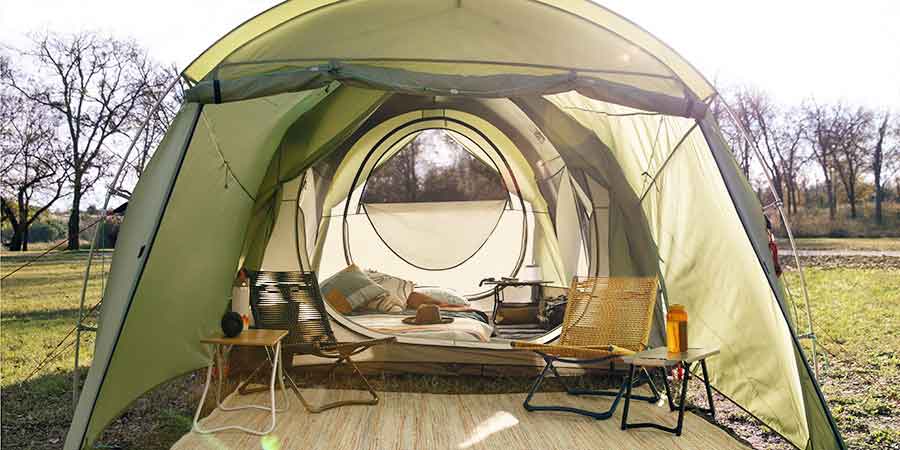
Bottom Line: Enjoy maximum living space in the Wonderland 6, which has two rooms that can easily accommodate families and folks looking to spread out.
Testing stats:
- Nights out: 60
- Testing states: Colorado, South Dakota, Utah, Washington
- Best testing story: “Google Maps is the key to good desert car camping,” one tester says (yes, he’s a millennial). “A little bit of scouring before this trip yielded some cool new ideas, but it wasn’t until we drove almost directly to the edge of a 1,000-foot-deep canyon and set up with a view over the rim that we realized how clutch that prep was.”
Buying Advice
Car camping tents tend to be larger, more spacious , and packed with features as compared to camping tents for backpacking but they’re additionally, they are heavier. It could be a hassle when you have to carry your camping gear around, but that’s not the charm of car camping. If you’re driving to your camp site the weight won’t be an issue. The tents listed in this list are spacious with plenty of features and are inexpensive. They’re not the most transportable but there are multi-purpose tents (like the Marmot Limestone 4P) which are lightweight enough to carry with, and still extremely comfortable in a campground in the front.
To select the ideal shelter for your needs be sure to consider these factors.
Capacity
Each tent model has the name of a model with a number that roughly corresponds to how many people could comfortably fit in, lying shoulder-to-shoulder. There’s no industry standard on how much space for each person consider the number as a maximum. four people could be accommodated in a tent that’s four people, but you’ll feel more at ease in a tent that can accommodate six people.
You should also look over the specifications of the tent before purchasing. The floor area will assist you in thinking about how the sleeping pads could be placed to make the most of space, while the peak height will tell the amount of headroom you’ll be able to enjoy.
Doors and Vestibules
The space within the principal body of the tent isn’t the only thing which is important. Particularly if you’re facing conditions or spending a lot of time in the shelter, it’s likely that you’ll need to take things out of it. That’s why vestibules are essential. These outdoor spaces that are indoors located on the opposite part of the entrance are enclosed and accessible from side of the tent however, they don’t consume any floor area. They are great for storage of extra equipment and wet clothes.
If you have more than two sleeping guests within your camp, having several doors is great. This lets guests get in and out without having to step over each other or causing any obstruction.
Features
Also, consider things like ventilation, organization and even colors. Additional features can increase the cost of shelters but they are worthwhile. The interior pockets, lofts for gear and gear loops help you take your sundries off the floor and away from the way, while preserving enough space on the floor to sleep. It’s nice to create a pocket for each person sleeping however, it’s not necessary.
The ability to eliminate the rainfly completely when you are enjoying favorable weather conditions can increase the sensation of being outdoors. If you’ve got a lot of people in a tent, or you are camping in the rain or in high humidity it is possible to have opening vents inside the tent to allow more airflow and reduce condensation.
A brightly colored tent can make the inside more comfortable and relaxing in the event of a gray and gloomy outside. It’s also visible from a distance. A neutral-colored tent in contrast will blend in with the surroundings better.
Methodology
In the summer and autumn of 2019, we’ve sent our members (and their families, friends and pets) across the nation to car camping areas and large areas of open public land to assess the best shelters you could locate at REI. They’ve faced scorching sunshine as well as unending rain and gale-force winds. They’ve inspected everything from windows that leak to privacy glass.
In the end, at the end of each test season, each tester scores the size of each shelter in terms of in terms of weather protection, quality, features, and overall usability. We summed these score to award each of the tents an overall score of 100. These seven tents have been proven to give you the best nights of sleeping. It is worth noting that the REI Co-op Wonderland 6, and Thule Tepui Explorer Ayer 2 excelled in all categories. The REI Co-op Skyward 4, Marmot Limestone 4P, and Kelty Discovery Basecamp 4 performed excellently in at minimum one but not all of the categories.
Related Articles
What is the best way to choose a Tent for Camping? Tent
How to Set Up the Tent
Article by Ryan Wichelns. Ryan is a freelance journalist and climber. His favorite climbs are the random, unaesthetic snow- and ice-covered heaps in the middle of nowhere that require a weeklong scree-choked slog to maybe climb. Don’t ask him why. REI member since 2017.
